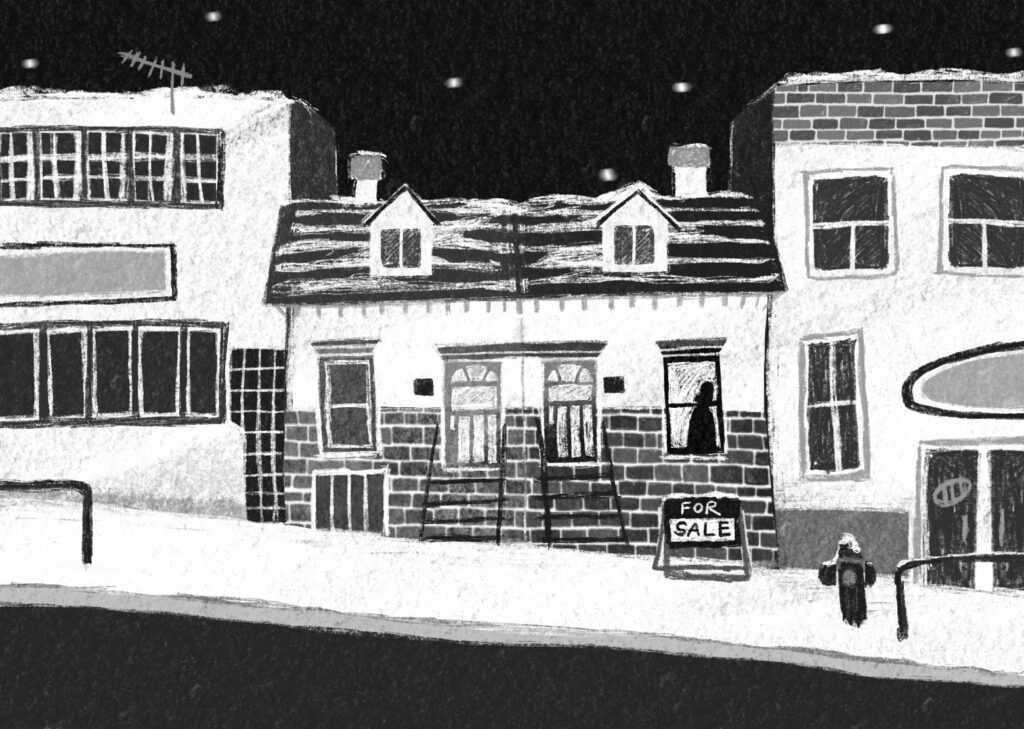In dream analysis, the image of a house often represents its owner’s sense of self. But what does it signify if you’re the house’s realtor? Elizabeth Ruth’s latest novel, Semi-Detached, explores this question and more. Set in 2013, the clever cozy mystery follows Laura, a middle-aged real estate agent who has been tasked with selling an older home — a “charming white wood frame with green trim”— in Toronto’s East End. Why? Six months prior, the reclusive owner, ninety-four-year-old Edna “Eddie” Ferguson, fell into a coma, and “there was no outstanding mortgage, no will or next of kin, and the property taxes were long overdue.”
Laura arrives to scope out the house alone while a blizzard rages. The “swift and brilliant” white‑out recalls the Great Snowstorm of 1944, a real-life event that blanketed the city in fifty-seven centimetres of snow and killed twenty-three people. (It also, of course, mirrors the major storm that slammed large swaths of Ontario in December 2013.) As Laura comes up to the house, an assertive eighteen-year-old, Astrid, who clutches a Scottish terrier and whose face features ”a string of star tattoos,” approaches the agent. “Invite me in,” she implores. “We’ve been out here a while.” But Laura refuses to let her through the door: “Maybe she was a meth addict? Lots of kids on the street used. What if Astrid mugged her?”
Conflicted about leaving the girl and her dog outside, Laura enters the house and is “flooded with a palpable mix of regret and longing.” She reflects on her last five years, including three miscarriages, a strained marriage to her wife, Cat, and the death of her mother. Feeling “the sort of exhaustion that comes on in a flash after exposure to the cold or a profound loss,” Laura falls asleep and has a vivid nightmare: a man with “his head smashed in, blood pooling around him like a crimson cloak” and a woman, “hands clenched to fists,” fleeing down the stairs. As the storm rages on, the “agent of convention,” who has been “waiting for something to drop into her life and break it open,” decides to play detective, exploring the connections she intuits between the dream and the house — and herself and its owner.
Laura turns to the well-preserved artifacts inside to uncover Eddie’s story. A rare woman working construction in the Leslieville area in 1944, the twenty-five-year-old “brick maker, puzzler, and two-time Regional Champion for the Toronto Women’s Bowling League” began a passionate affair with Annie, the daughter of her abusive boss, Mr. Armstrong. With each clue Laura finds, the narrative shifts to the past and readers get a deeper view of the couple’s tumultuous relationship. The romance includes joyful experiences at the Danforth Woodbine Bowling Alley and the historic Rideau Club, on Gerrard Street East, but disquieting episodes too. Eddie and Annie struggle to keep their relationship under wraps, particularly from the intolerant boss with the “quick, ferocious temper.”

A real estate agent in Toronto takes her research to the next level.
Nicole Iu
Laura continues her investigation after her first visit, but her efforts are complicated by dinner plans, friends with new babies, and power outages. And she repeatedly — and mysteriously — keeps running into Astrid: “Should Laura threaten to call the police? And tell them what? That a teenager was stalking her?” All the while, she grieves her late mother despite the precariousness of having been raised by an “underemployed performance artist.” Indeed, while Laura is grateful for her current privilege, when even “the incredible debt she and Cat had accumulated paying for donor sperm and IVF” only inconveniences “the trips they might’ve taken,” she’s aware of the toll her lucrative career has taken on her personal life: “She found people houses for a living and yet no one had been willing to take up residence inside of her.” Laura has grown so desperate for “emotional engagement” that she has decided to prepare for an embryo transfer, to try for a fourth time to have a child, without telling Cat: “As long as there was the slightest chance, the faintest hope, even a thread of love, she’d hold on to that.”
Throughout, Ruth incorporates historical details about Toronto, the Great Snowstorm, and the experiences of Canada’s working women and queer people. These contextualize the story and heighten its emotional weight, though they’re sometimes shoehorned into the proceedings (such as those about mid-twentieth-century health care, instigated by Annie and Eddie conveniently stumbling into a birth control reform protest). Moreover, the author may ask too much of the novel’s central metaphor: the house. Ruth lets it simultaneously represent a marriage, a body, and a mind, and describes the concept of “home” as “a sheltering sanctuary of love where prayers could be answered.” Such hyperbole and lack of focus undermine the well-defined relationships and characters.
Additionally, erudite readers may find some of the twists and turns predictable. These include the revelations that Astrid may not be who she appears and that Eddie, whose mind is as active as her body is comatose, “knew what the doctors didn’t: the coma was buying time, not wasting it.” All told, however, Semi-Detached proves a satisfying read. The fast-paced narrative never stalls for long, and the parallel storylines in 2013 and 1944 progress cohesively. And by drawing equivalencies between the apparently unrelated figures Laura and Eddie, Ruth convincingly suggests to readers that the choices they make — and are made to make — are part of lives (and dreams) that are never just their own.
Véronique Darwin writes and teaches in Rossland, British Columbia.

